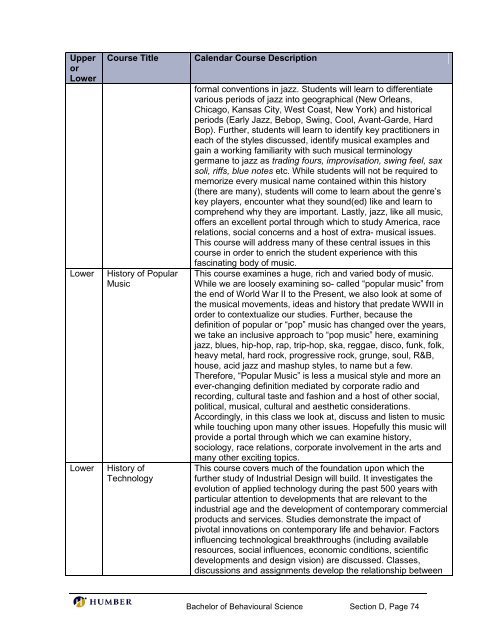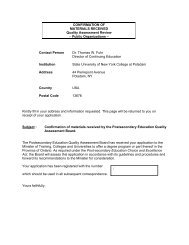Bachelor of Behavioural Science - Postsecondary Education Quality ...
Bachelor of Behavioural Science - Postsecondary Education Quality ...
Bachelor of Behavioural Science - Postsecondary Education Quality ...
You also want an ePaper? Increase the reach of your titles
YUMPU automatically turns print PDFs into web optimized ePapers that Google loves.
Upper<br />
or<br />
Lower<br />
Lower<br />
Lower<br />
Course Title<br />
History <strong>of</strong> Popular<br />
Music<br />
History <strong>of</strong><br />
Technology<br />
Calendar Course Description<br />
formal conventions in jazz. Students will learn to differentiate<br />
various periods <strong>of</strong> jazz into geographical (New Orleans,<br />
Chicago, Kansas City, West Coast, New York) and historical<br />
periods (Early Jazz, Bebop, Swing, Cool, Avant-Garde, Hard<br />
Bop). Further, students will learn to identify key practitioners in<br />
each <strong>of</strong> the styles discussed, identify musical examples and<br />
gain a working familiarity with such musical terminology<br />
germane to jazz as trading fours, improvisation, swing feel, sax<br />
soli, riffs, blue notes etc. While students will not be required to<br />
memorize every musical name contained within this history<br />
(there are many), students will come to learn about the genre‘s<br />
key players, encounter what they sound(ed) like and learn to<br />
comprehend why they are important. Lastly, jazz, like all music,<br />
<strong>of</strong>fers an excellent portal through which to study America, race<br />
relations, social concerns and a host <strong>of</strong> extra- musical issues.<br />
This course will address many <strong>of</strong> these central issues in this<br />
course in order to enrich the student experience with this<br />
fascinating body <strong>of</strong> music.<br />
This course examines a huge, rich and varied body <strong>of</strong> music.<br />
While we are loosely examining so- called ―popular music‖ from<br />
the end <strong>of</strong> World War II to the Present, we also look at some <strong>of</strong><br />
the musical movements, ideas and history that predate WWII in<br />
order to contextualize our studies. Further, because the<br />
definition <strong>of</strong> popular or ―pop‖ music has changed over the years,<br />
we take an inclusive approach to ―pop music‖ here, examining<br />
jazz, blues, hip-hop, rap, trip-hop, ska, reggae, disco, funk, folk,<br />
heavy metal, hard rock, progressive rock, grunge, soul, R&B,<br />
house, acid jazz and mashup styles, to name but a few.<br />
Therefore, ―Popular Music‖ is less a musical style and more an<br />
ever-changing definition mediated by corporate radio and<br />
recording, cultural taste and fashion and a host <strong>of</strong> other social,<br />
political, musical, cultural and aesthetic considerations.<br />
Accordingly, in this class we look at, discuss and listen to music<br />
while touching upon many other issues. Hopefully this music will<br />
provide a portal through which we can examine history,<br />
sociology, race relations, corporate involvement in the arts and<br />
many other exciting topics.<br />
This course covers much <strong>of</strong> the foundation upon which the<br />
further study <strong>of</strong> Industrial Design will build. It investigates the<br />
evolution <strong>of</strong> applied technology during the past 500 years with<br />
particular attention to developments that are relevant to the<br />
industrial age and the development <strong>of</strong> contemporary commercial<br />
products and services. Studies demonstrate the impact <strong>of</strong><br />
pivotal innovations on contemporary life and behavior. Factors<br />
influencing technological breakthroughs (including available<br />
resources, social influences, economic conditions, scientific<br />
developments and design vision) are discussed. Classes,<br />
discussions and assignments develop the relationship between<br />
<strong>Bachelor</strong> <strong>of</strong> <strong>Behavioural</strong> <strong>Science</strong> Section D, Page 74
















